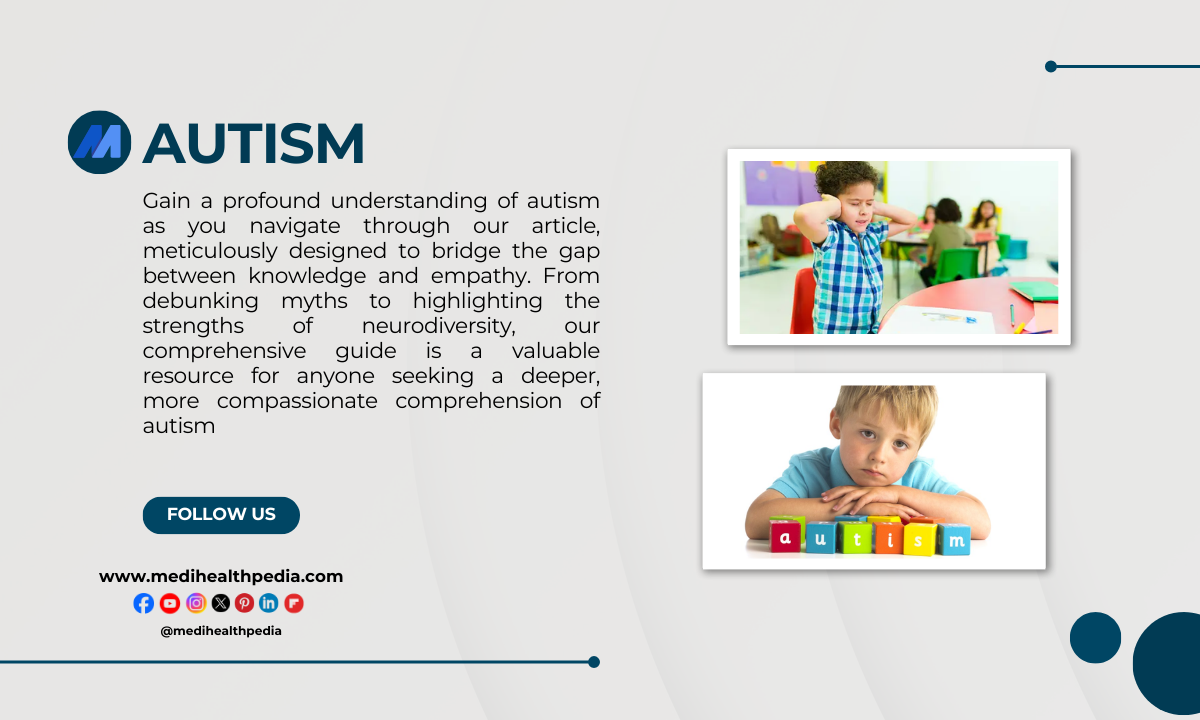Empowering Parents: A Journey of Understanding and Nurturing Autism
Introduction
Autism spectrum disorder (ASD) is a multifaceted neurological condition that shapes the way individuals perceive and interact with the world around them. In this extensive guide, we will embark on a journey to comprehend the intricate landscape of autism. From foundational insights and clinical presentations to diagnostic workups, potential complications, conventional treatment options, preventive strategies, herbal medicines for treatment, lifestyle modifications, and a conclusive perspective, this article seeks to provide a holistic understanding of autism.

Understanding Autism Spectrum Disorder
To navigate the complexities of autism, it’s essential to establish a foundational understanding of what autism spectrum disorder entails.
- Autism Spectrum Disorder Defined
Autism spectrum disorder is a developmental disorder that impacts an individual’s social interaction, communication skills, and behavior. The term “spectrum” acknowledges the wide variation in challenges and strengths that individuals with autism may exhibit.
- Prevalence and Impact
Autism is a prevalent condition, with a diverse range of manifestations. Its impact can vary from mild to severe, influencing the individual’s ability to communicate, learn, and engage in daily activities.
Clinical Presentation: Recognizing the Signs and Symptoms
Autism spectrum disorder manifests in a spectrum of signs and symptoms, each contributing to the unique profile of the individual. Common presentations may include:
- Impaired Social Interaction: Difficulty in understanding and responding to social cues, leading to challenges in forming relationships.
- Communication Challenges: Limited verbal communication, challenges in understanding and using non-verbal communication such as gestures and facial expressions.
- Repetitive Behaviors: Engaging in repetitive movements or activities, such as hand-flapping or rocking.
- Sensory Sensitivities: Heightened or reduced sensitivity to sensory stimuli, such as light, sound, or touch.
- Fixation on Routines: A strong preference for routines and resistance to change.
- Difficulty in Empathy: Challenges in understanding others’ perspectives or feelings.
- Exceptional Skills or Talents: Some individuals with autism may have exceptional skills or talents, such as in music, art, or mathematics.
Workup: Unraveling the Diagnosis
Diagnosing autism spectrum disorder involves a comprehensive evaluation, considering various factors such as developmental history, observed behaviors, and standardized assessments. Key components of the diagnostic workup include:
- Developmental Screening
- Modified Checklist for Autism in Toddlers (M-CHAT): A tool commonly used for early screening, particularly in toddlers.
- Comprehensive Developmental Evaluation
- Autism Diagnostic Observation Schedule (ADOS): A standardized observational tool to assess social interaction, communication, and play.
- Parental and Caregiver Interviews
- Autism Diagnostic Interview-Revised (ADI-R): A structured interview to gather information about the individual’s behavior and development.
- Medical Evaluation
- Genetic Testing: In some cases, genetic testing may be recommended to identify any genetic factors associated with autism.
- Neuroimaging: Imaging studies such as MRI or CT scans may be conducted to rule out any structural abnormalities in the brain.
Complications and Associated Conditions
Autism spectrum disorder can be accompanied by various complications, affecting different aspects of an individual’s life:
- Intellectual Disabilities: Some individuals with autism may experience intellectual challenges.
- Communication Challenges: Difficulty in expressing needs and desires verbally.
- Mental Health Conditions: Higher rates of coexisting conditions such as anxiety, depression, or attention-deficit/hyperactivity disorder (ADHD).
- Challenges in Daily Living: Difficulties in activities of daily living, including self-care and independent living.
Conventional Treatment Options
The management of autism involves a multidisciplinary approach aimed at addressing the unique needs of each individual. Common treatment options include:
- Behavioral Therapies
- Applied Behavior Analysis (ABA): A structured approach to encourage positive behaviors and discourage negative ones.
- Speech and Language Therapy: Helps individuals improve communication skills.
- Occupational Therapy: Focuses on developing daily living skills and managing sensory sensitivities.
- Medications
- Antipsychotic Medications: May be prescribed to manage challenging behaviors.
- Selective Serotonin Reuptake Inhibitors (SSRIs): Used to address anxiety and depression symptoms.
- Educational Interventions
- Individualized Education Program (IEP): Tailored educational plans to meet the unique needs of the individual.
- Parental and Caregiver Training
- Parent-Child Interaction Therapy (PCIT): A therapeutic approach that involves parents in the treatment process.
Prevention Strategies
While there is no known way to prevent autism spectrum disorder, early intervention and supportive measures can significantly improve outcomes. Key strategies include:
- Early Intervention Services: Accessing services such as speech therapy and behavioral interventions at an early age.
- Genetic Counseling: For families with a history of genetic conditions associated with autism.
Herbal Medicines for Autism
The use of herbal medicines for autism is an area that requires careful consideration. While some herbs may have anecdotal support for managing certain symptoms, it’s crucial to approach this cautiously and under the guidance of healthcare providers. Potential herbal options include:
- Melatonin: Some studies suggest a role in managing sleep disturbances associated with autism.
- Omega-3 Fatty Acids: Found in fish oil, these fatty acids may have potential benefits for cognitive function.
Lifestyle Modifications
Lifestyle modifications can significantly enhance the well-being of individuals with autism and their families:
- Structured Routine: Establishing and maintaining a consistent daily routine can provide a sense of predictability.
- Sensory-Friendly Environment: Creating a sensory-friendly living space by considering lighting, noise levels, and textures.
- Social Skills Training: Engaging in social skills training programs to improve interpersonal interactions.
- Parental Support Groups: Participating in support groups to connect with other parents facing similar challenges.
Conclusion
Autism spectrum disorder is a unique journey for each individual and their family. Understanding the signs, seeking an early diagnosis, and implementing tailored interventions are essential steps on this path.
Accurate diagnosis, comprehensive intervention, and ongoing support play pivotal roles in fostering the well-being of individuals with autism. While conventional treatments and therapies form the cornerstone of management, exploring complementary approaches, including herbal medicines, should be done with caution and in consultation with healthcare providers.
In conclusion, embracing the diversity within the spectrum and providing a supportive, understanding environment can empower individuals with autism to navigate life with resilience and dignity.

